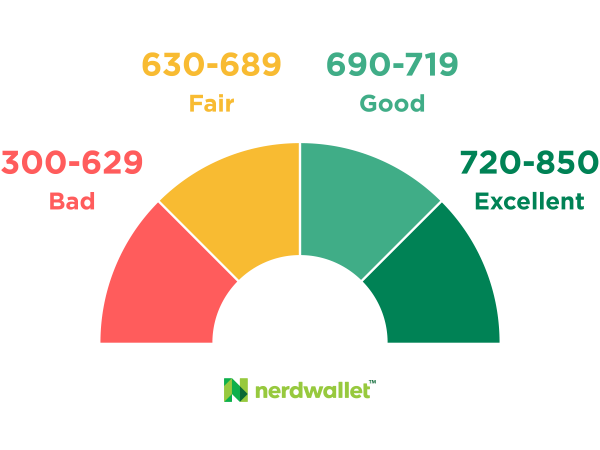How to Get the Best Mortgage Rate

Some or all of the mortgage lenders featured on our site are advertising partners of NerdWallet, but this does not influence our evaluations, lender star ratings or the order in which lenders are listed on the page. Our opinions are our own. Here is a list of our partners.
After the sticker price of the home, your interest rate is the biggest influence on your monthly mortgage payments. With a higher rate, interest takes up a larger share of your monthly housing budget, and it might also affect the price range that you can comfortably shop.
Though it can feel like you’re at the mercy of lenders and the market, there are steps you can take to improve the rates you’re offered, potentially saving thousands of dollars and growing your homebuying budget.

1. Strengthen your financial profile
The best mortgage rates are typically reserved for borrowers with the best credit scores, so you’ll want to know where your credit score will stand with lenders. Scores in the highest range (720-850) are considered “excellent,” while scores in the 690-719 range are “good,” scores in the 630-689 range are “fair,” and scores in the 300-629 range are “bad.”

You can grow your credit score by paying your bills on time, as well as by paying down debt to reduce the amount of credit you’re using and maintaining low credit balances. Keep your cards open to prevent your utilization from going up. You’ll also want to pay off any debts that have gone to collections.
NerdWallet recommends that you request free credit reports from the three major credit reporting bureaus (Experian, Equifax and TransUnion) and dispute any errors that might be suppressing your credit score. You can access these reports at AnnualCreditReport.com.
In addition to your credit score, lenders will also consider your debt-to-income ratio (DTI). This is the percentage of your gross monthly income that goes toward paying your debts. This number does not include nondebt expenses, such as groceries or utilities.
Lenders typically want this number to be no higher than 36%; the lower, the better. Paying down credit card debt will also improve your debt-to-income ratio. You can find this number using NerdWallet’s DTI calculator.
at Next Door Lending LLC
*This is to give you notice that NerdWallet Compare, Inc. (“NW Compare”), and its parent company, NerdWallet, Inc. (“NerdWallet”), have a business relationship with Next Door Lending, LLC (“Next Door Lending”), which is a wholly owned subsidiary of NerdWallet. Because of these relationships, any referrals of you to Next Door Lending by any NerdWallet company may provide the referring company and its direct or indirect parent company with a financial or other benefit. You are NOT required to use Next Door Lending to obtain access to any settlement service. THERE ARE FREQUENTLY OTHER SETTLEMENT SERVICE PROVIDERS AVAILABLE WITH SIMILAR SERVICES. YOU ARE FREE TO SHOP AROUND TO DETERMINE THAT YOU ARE RECEIVING THE BEST SERVICES AND THE BEST RATE FOR THESE SERVICES.
2. Make a larger down payment
Being able to put a larger amount down on a house will lower your loan-to-value ratio (LTV) and generally also your mortgage rate. For example, if you make a 20% down payment, your LTV is 80%.
Conventional mortgage borrowers who put down less than 20% are also required to pay private mortgage insurance (PMI), an additional monthly expense. When looking at lender rates online, be aware that the advertised rate often assumes that the borrower is putting down 20% or more.
3. Consider paying points
Discount points are fees borrowers pay to reduce the interest rate on their mortgages. One point costs 1% of the loan amount, which typically reduces the mortgage rate by 0.25%, although the reduction can vary.
When you pay discount points, you typically shell out thousands of dollars upfront to save a few dollars every month. The more points you buy, the larger your monthly savings will be. You’ll likely have to pay at least three or four discount points to save more than $100 each month. It takes several years for your total savings to exceed the initial amount paid. This break-even period varies depending on the loan amount, the cost of the points and the interest rate.
You can calculate the potential savings of paying points and find the break-even period using NerdWallet’s mortgage points calculator. If the break-even period exceeds the amount of time you plan to be in the home, then buying points probably isn’t worth it.
For example, if you pay $3,000 for one discount point on a $300,000 mortgage, you could bring your mortgage rate down from 6.75% to 6.5%. This would result in monthly savings of $50, with a break-even period of five years to recoup the cost of the point.
4. Take advantage of first-time home buyer programs
Before you settle on a mortgage, find out whether you’re eligible for any special programs that make homebuying less costly. Many states offer help to first-time home buyers as well as repeat buyers.
Each state offers its own mix of programs, often including down payment assistance, combined with favorable interest rates and tax breaks. Some programs are targeted geographically, and others offer help to home buyers in certain professions, such as teachers, first responders and veterans.

5. Shop around with multiple lenders
You probably wouldn’t commit to buying the first home you tour, right? You’d shop around until you found one that fits your needs and is affordable. The same philosophy can be applied to finding a lender. If you have an existing relationship with a lender, they can be a great place to start, especially if they offer discounts to current customers. However, applying for preapproval with a few lenders gives you an opportunity to compare offers and see who is offering the lowest rate.
6. Consider alternative types of mortgages
Though 30-year fixed-rate mortgages are popular among homebuyers, other types of mortgages can come with lower rates.
For example, adjustable-rate mortgages (ARMs) can have introductory rates below market. These mortgages have a fixed rate for a certain number of years before changing on a regular cadence, usually every six months. For example, a 5/6 ARM will have a fixed interest rate for five years before adjusting every six months. This can be risky because you’ll have to pay more if rates rise. However, these mortgages can be a strategic choice if you plan to sell before the fixed period ends.
You can also choose a shorter loan term; 15-year mortgages often have lower interest rates than 30-year mortgages. Because you’ll have less time to pay it off, your monthly payments will be higher. However, you’ll save on the overall loan because you’ll be making fewer interest payments.
Loans backed by the Federal Housing Administration (FHA) can also have lower rates than conventional mortgages as well as more flexible qualification requirements.
However, you'll have to pay a monthly insurance premium. If you’re able to make a down payment of 10% or more, you can cancel this insurance payment after 11 years. Otherwise, you’ll be required to keep paying it for the life of the loan or until you refinance.
You could also consider a shared appreciation mortgage (SAM), which involves giving a lender a percentage of the future appreciation of the home in exchange for a below-market interest rate or another kind of perk. In addition to making monthly loan payments, you’d pay any remaining principal balance at the end of the term plus a percentage of its appreciated value. Beware that if your home grows in value, you’ll be obligated to pay more to the lender. Under the terms of a traditional mortgage, you would retain any accumulated equity.
On a similar note...
How much house can you afford?
Understanding how much you can afford is a great first step to buying a home. NerdWallet helps you easily determine your home buying budget with our home affordability calculator.




